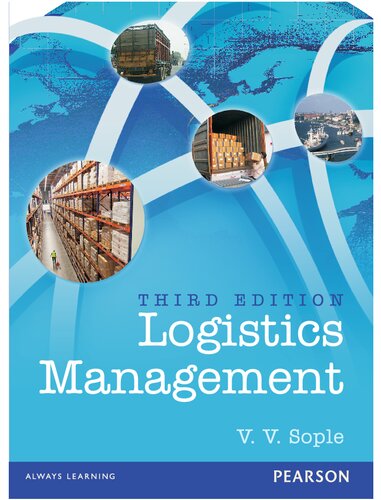(Ebook PDF) Logistics Management 3rd Edition by Sople 8131768624 9788131768624 Full chapter
$50.00 Original price was: $50.00.$35.00Current price is: $35.00.
Logistics Management 3rd Edition by V. V. Sople – Ebook PDF Instant Download/Delivery: 8131768624, 978-8131768624
Full dowload Logistics Management 3rd Edition after payment

Product details:
ISBN 10: 8131768624
ISBN 13: 978-8131768624
Author: V. V. Sople
Logistics management, 3/e is essential for creating value for both customers and stakeholders. Effective Logistic chains help organizations to compete in both global and domestic markets. The book addresses these issues in 5 parts, which deal with the basics of Logistics, Logistics Mix, Strategic approaches in managing logistics, Logistics controls and cases. The author has used diagrams and examples for students to better appreciate the concepts.
Logistics Management 3rd Table of contents:
Part 1: Caselets
- GCMMF (AMUL)—Managing Logistics to Align Customer Demands
- Gati Air Express—Redefining Logistics Connectivity
- CEAT—Redesigning the Supply Chain System
- Logistics: At the Centre of World Trade
1. Logistics Overview
- 1.1 A Paradigm Shift
- 1.2 Logistics Defined
- 1.3 Scope of Logistics
- 1.4 Logistics—A System Concept
- 1.5 Customer Value Chain
- 1.6 Logistics Functions
- Order Processing
- Inventory Management
- Warehousing
- Transportation
- Material Handling and Storage Systems
- Logistical Packaging
- Information
- 1.7 Logistics for Business Excellence
- Procurement
- Processing
- Distribution
- 1.8 Logistics Management—Objectives
- Inventory Reduction
- Reliable and Consistent Delivery Performance
- Freight Economy
- Minimum Product Damages
- Quick Response
- 1.9 Logistics Solution
- 1.10 Logistics Future
- Summary & Endnotes
- Review Questions
- Internet Exercises
- Video Links
- Bibliography
2. Customer Service in Logistics
- 2.1 Customer Service for Competitiveness
- 2.2 Customer Service Phases
- Pre-Transaction Phase
- 2.3 Service Attributes
- Order Process Time
- Delivery Consistency
- Delivery Frequency
- Stock Availability
- Credit Facility
- Stock Financing
- Service Support
- Handling Convenience
- 2.4 Value Added Logistical Services
- Summary & Endnote
- Review Questions
- Internet Exercises
- Video Links
- Bibliography
3. Supply Chain Management
- 3.1 What is Supply Chain Management?
- 3.2 Supply Chain Linkages
- Procurement
- Processing
- Distribution
- 3.3 Role of Logistics in the Supply Chain
- 3.4 Mapping the Supply Chain
- 3.5 E-Business Solutions for Supply Chain
- Summary & Review Questions
- Internet Exercises
- Video Links
- Bibliography
Part 2: Caselets
- Snowman Frozen Foods Ltd.—Providing One-Stop Logistics Solution in Cold Distribution
- Transport Corporation of India—‘Indian Road Freight Index’: Tracking Freight Rates
- Trans India Freight Services—Redefining Automotive Logistics Packaging
4. Warehousing
- 4.1 Warehousing—A Logistical Challenge
- 4.2 Warehousing Functions
- Material Storage Function
- Material Handling Function
- Information Handling Function
- 4.3 Warehouse Options—A Strategic Decision
- Private Warehouse
- Public Warehouse
- Contract Warehouse
- 4.4 Warehouse Site Selection
- 4.5 Warehouse Layout Design
- 4.6 Warehouse Decision Model
- 4.7 Warehouse Costing
- 4.8 Warehousing Strategies
- Capacity Switching
- Hub Networking
- Outsourcing
- 4.9 Virtual Warehouse
- 4.10 Warehouse Charter
- 4.11 Performance Parameters
- 4.12 Warehousing in India
- 4.13 Cold Chain Infrastructure
- Summary & Endnote
- Review Questions
- Internet Exercises
- Video Links
- Bibliography
5. Material Handling Systems
- 5.1 Role of Material Handling in Logistics
- 5.2 Material Handling Guidelines
- 5.3 Material Handling Equipment and Systems
- Manual
- Mechanized
- Semi-automatic
- Automated
- Summary & Review Questions
- Internet Exercises
- Video Links
- Bibliography
6. Material Storage Systems
- 6.1 Introduction
- 6.2 Unit Load Storage
- 6.3 Storage Principles
- 6.4 Storage Design—Benefits
- 6.5 Storage Methods
- Block Storage
- Racking Systems
- Shelving Systems
- Pallets
- Automatic Storage and Retrieval System (ASRS)
- Summary & Endnote
- Review Questions
- Internet Exercises
- Video Links
- Bibliography
7. Inventory Management
- 7.1 Inventory—Asset or Liability?
- 7.2 Inventory Functions
- Manufacturer
- Wholesaler
- Retailer
- 7.3 Inventory Functionality
- 7.4 Reasons for Carrying Inventories
- 7.5 Inventory-Related Costs
- 7.6 Inventory Controls
- Selective Control Techniques
- ABC, VED, SAP, FSN Analysis
- 7.7 Kanban
- 7.8 Inventory Policy Guidelines
- 7.9 Square Root Law (SRL) of Inventory
- Summary & Endnote
- Review Questions
- Internet Exercises
- Video Links
- Bibliography
8. Transportation
- 8.1 Evolution of Transportation System
- 8.2 Transportation Infrastructure
- Road, Railways, Sea, Air, Inland Water, Pipelines
- 8.3 Freight Management
- 8.4 Factors Influencing Freight Cost
- 8.5 Transportation Networks
- 8.6 Route Planning
- 8.7 Containerization
- Summary & Endnote
- Review Questions
- Internet Exercises
- Video Links
- Bibliography
9. Logistical Packaging
- 9.1 Consumer vs. Logistical Packaging
- 9.2 Packaging as Unitization
- 9.3 Design Considerations
- 9.4 Packaging Material
- Corrugated Fibreboard, Steel, Plastics, Wood
- 9.5 Returnable Logistical Packaging
- 9.6 Packaging Cost
- Summary & Endnotes
- Review Questions
- Internet Exercises
- Video Links
- Bibliography
10. Logistics Information System
- 10.1 Logistics Information Needs
- 10.2 Designing Logistics Information System
- 10.3 Desired Characteristics of LIS
- Summary & Endnote
- Review Questions
- Internet Exercises
- Video Links
- Bibliography
Part 3: Caselets
- CPMC Relocation and Logistics Pvt. Ltd.—Relocation Logistics
- Nokia—Reverse Logistics Initiatives for Used Mobile Phones
- Global Logistics Supply Chain Model for Value Creation
11. Logistics Design for Distribution Channels
- 11.1 Role of Logistics in Distribution Channel
- 11.2 Distribution Channel Structure
- 11.3 Logistic Requirements of Channel Members
- 11.4 Channel Strategy
- 11.5 Logistics Support to the Distribution Channel
- Summary & Endnotes
- Review Questions
- Internet Exercises
- Video Links
- Bibliography
12. Logistics Outsourcing
- 12.1 Catalysts for Outsourcing Trends
- 12.2 Benefits of Logistics Outsourcing
- 12.3 Third-Party & Fourth-Party Logistics
- 12.4 Service Provider Selection
- 12.5 Value-Added Services
- 12.6 Logistics Service Contract
- 12.7 Critical Issues
- 12.8 Outsourcing Value Proposition
- Summary & Endnotes
- Review Questions
- Internet Exercises
- Video Links
- Bibliography
13. E-commerce Logistics
- 13.1 A New Way of Shop and Pay
- 13.2 E-commerce: Requirements on Logistics
- 13.3 E-logistics Structure and Operation
- 13.4 Logistics Resource Management
- Summary & Endnotes
- Review Questions
- Internet Exercises
- Video Links
- Bibliography
14. Technology in Logistics
- 14.1 Role of Technology
- 14.2 Automatic Identification Technology
- 14.3 Communication Technology
- 14.4 Automated Material Handling
- 14.5 Warehouse Simulation
- 14.6 Information Technology
- Summary & Endnotes
- Review Questions
- Internet Exercises
- Video Links
- Bibliography
15. Reverse Logistics
- 15.1 Why Reverse Logistics?
- 15.2 Scope of Reverse Logistics
- 15.3 System Design Considerations
- 15.4 Reverse Logistics—A Competitive Tool
- Summary & Endnotes
- Review Questions
- Internet Exercises
- Video Links
- Bibliography
16. Global Logistics
- 16.1 Why Global Logistics?
- 16.2 Operational Factors
- 16.3 Strategic Issues
- Summary & Endnotes
- Review Questions
- Internet Exercises
- Video Links
- Bibliography
17. Strategic Logistics
- 17.1 Logistics Competitive Framework
- 17.2 Logistics Strategies Across PLC
- 17.3 Strategic Logistics Planning
- 17.4 Logistics Strategies
- 17.5 Strategy Implementation
- Summary & Endnotes
- Review Questions
- Internet Exercises
- Video Links
- Bibliography
Part 4: Caselets
- Mahindra Logistics—Innovating Business Models in Freight
- Bharat Petroleum—Strategic Fuel Supply Chain Management
People also search for Logistics Management 3rd:
supply chain and logistics management
cardinal logistics management
transport and logistics management
importance of logistics management
international journal of logistics management
Tags:
Sople,Logistics,Management 3rd


